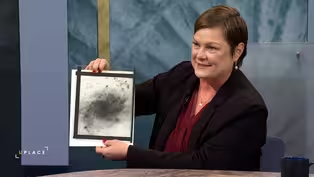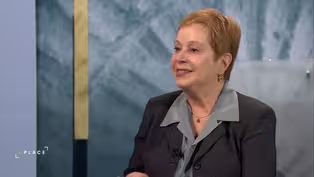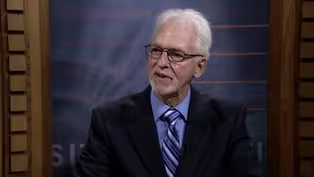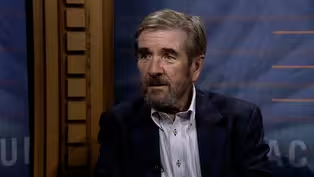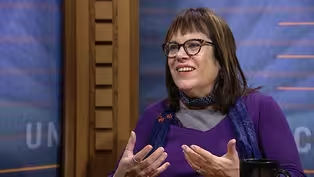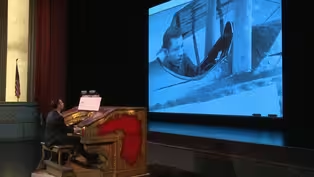
American Revolutionary War Tactics
Special | 59m 27sVideo has Closed Captions
John Hall examines weapons and tactical development during Revolutionary War battles.
John Hall, professor of history at the University of Wisconsin-Madison, discusses weapons, training styles and tactical development during the American Revolutionary War.
Problems playing video? | Closed Captioning Feedback
Problems playing video? | Closed Captioning Feedback
University Place is a local public television program presented by PBS Wisconsin
University Place is made possible by the Corporation for Public Broadcasting.

American Revolutionary War Tactics
Special | 59m 27sVideo has Closed Captions
John Hall, professor of history at the University of Wisconsin-Madison, discusses weapons, training styles and tactical development during the American Revolutionary War.
Problems playing video? | Closed Captioning Feedback
How to Watch University Place
University Place is available to stream on pbs.org and the free PBS App, available on iPhone, Apple TV, Android TV, Android smartphones, Amazon Fire TV, Amazon Fire Tablet, Roku, Samsung Smart TV, and Vizio.
More from This Collection
John DeMain: The Maestro Remembers the Early Years
Video has Closed Captions
John DeMain shares his musical journey from childhood through his early conducting career. (57m 23s)
Yerkes Observatory: Past and Future
Video has Closed Captions
Amanda Bauer discusses the observatory's 125 years of astronomical research and education. (56m 55s)
The Effects of Video on Early Childhood Development
Video has Closed Captions
Heather Kirkorian describes positive and negative effects of video on young children. (56m 23s)
American Indians and the American Dream
Video has Closed Captions
Kasey Keeler talks about federal Indian policy and American Indian suburbanization. (53m 27s)
Video has Closed Captions
Allison Prasch examines the use of rhetoric by 20th century U.S. presidents. (55m 58s)
Video has Closed Captions
Sissel Schroeder shares the history of the largest archeological site in Wisconsin. (54m 24s)
Phosphorus and a World Out of Balance
Video has Closed Captions
Dan Egan talks about the life-sustaining, as well as the deadly, qualities of phosphorus. (54m 8s)
Frederick Douglass: Freedom's Voice
Video has Closed Captions
Greg Lampe explores the life of the great 19th-century orator and civil rights leader. (58m 14s)
Ukraine and Russia: Prelude to War
Video has Closed Captions
David McDonald describes the long and complex history between Ukraine and Russia. (59m 26s)
A Celebration of American Song
Video has Closed Captions
Trevor Stephenson and a vocal quartet perform historic American songs. (54m 35s)
The Crusade for Food Safety at the Turn of the Century
Video has Closed Captions
Deborah Blum joins Norman Gilliland to discuss dangerous food and beverage additives. (59m 37s)
Video has Closed Captions
Organist Jelani Eddington accompanies the 1926 silent film “The Flying Ace.” (57m 55s)
Providing Support for PBS.org
Learn Moreabout PBS online sponsorship[gentle music] - Norman Gilliland: Welcome to University Place Presents.
I'm Norman Gilliland.
The paintings are beautiful: Valley Forge, The Battle of Bunker Hill, Braddock's Defeat, and many other images from the American Revolution.
But what was actually going on that led up to those formative moments in American history?
How did Americans learn to fight and win a war against the greatest power in the world at the time?
With me is John Hall, Professor of History at the University of Wisconsin-Madison.
- Hi, Norman, great to be with you today.
- Welcome to University Place Presents.
- Thanks.
- It's an image that we see, these squared-off troops fighting each other in what today looks suicidal.
Out in the open, taking turns to load, taking turns to shoot at each other.
And something happened, though, in America that got Americans away from that kind of fighting.
But we also have this image of everybody hiding behind rocks and shooting at these red-coated British soldiers out in the open.
How did Americans start out?
- Well, it's complicated, right, as with just about anything.
They brought over-- So, European colonists to North America brought over, of course, systems of knowledge about military art and science that proved very tenacious.
And for quite a long time, they continued to adhere to those models, in large part because their economies were relatively simple and shallow.
Their foremost profession was not to be soldiers.
And so they couldn't really develop any particular expertise.
And so the early colonists actually brought over with them professional soldiers like Myles Standish, who actually knew the business, so that they could train people in rudimentary military skills.
But they were still using very much European tactics at the time.
And these were not terribly well-suited to North American conditions.
So gradually, as these populations grew and allowed for a little bit of economic specialization, they developed the first proto-professional formations in North American history from European ranks, and we typically refer to these formations as Rangers.
And what the Rangers would do is essentially mimic Indian doctrine and tactics, and that was to conduct very long-range raids and try to strike fear into their enemies, a psychologically devastating brand of warfare.
Strategically, it wasn't terribly effectual.
But those, I think, were kind of the first seeds of a cross-cultural transformation and exchange of military practices that produced a hybridization of forms of warfare in North America.
But that's in the early going.
It becomes even more complex as we move into the 18th Century.
- We call it here the French and Indian War.
It was actually just the North American front of the Seven Years' War, which had been a major force in Europe, continental Europe.
But was formative, wasn't it, in the development of North American or even American fighting tactics?
- Yeah, that's absolutely true, although not, I think, in the way that generations of American school children might have learned about this, and familiarity with this image here, this famous image of Major General Edward Braddock dying while George Washington, his aide for this expedition and the de facto commander of Virginia's Provincial Regiment, looks on.
By the American mythological telling of this, this was the foolish British bringing their outdated, ill-suited tactics to North America, getting slaughtered wholesale by French and Native American forces, who really knew how to fight in the North American woodlands.
And by the mythological telling of this, this is really formative in the development of George Washington's thinking about war, and he will forswear these kinds of British tactics and so forth.
That's not exactly what happens here.
In point of fact, Washington will allege that the problem with the British force in this expedition was that they were using the wrong European formations, that they were in close-order formations when they should have been in more open-order formations, and more to the point that the enlisted men panicked, that they were not disciplined.
Which is sort of ironic, because the argument that he's making, essentially, is they weren't regular enough.
They weren't Europe-- They weren't fighting like Redcoats are supposed to fight.
He had nothing but fond things to say about all of the British officers, Braddock foremost among them.
Washington, for the rest of his life, looked upon the deceased Braddock as something of a role model.
And right after this fight, one of the first things that Washington did is order 1740s vintage treatise on traditional military discipline and tactics so he could train his own Virginia provincials to fight more like the British, rather than less like the British, albeit hoping for better results than Braddock met here in July of 1755, of course.
That said, the British learn a lot from the Seven Years' War in North America, or the French and Indian War.
And by the end of that conflict, they have developed their own expertise in North American woodland fighting.
In point of fact, within the British Army at this time, there are two schools, if you will.
There's the German school, and there's the American school.
And it's all about where they cut their teeth.
And they have very different preferences about how to fight.
It's just another element of American mythology, is that the British learned next to nothing from this war in North America and come back and try the same thing again in 1775, which is frankly not true.
- Well, when we say the French and Indian War, that is the French and Indians on one side and the Americans and British on the other.
Well, how are the French, then, mixing their tactics with the Native Americans?
- So the French, I would argue, become masters of this North American, hybridized form of warfare earlier and to a greater extent than the British, because they are so much more reliant upon their Native American allies.
And so when we say French and Indian on one side, I think we should put the word "Indian" in bold and underline it and so forth, because they, the French, are genuinely dependent upon their Native American allies by virtue of geography.
There's not enough arable land up there.
These are not self-sufficient colonies.
So they remain very dependent upon a fragile, seaborne tether back to Europe for resupply.
They are not, despite French efforts to make them so, sustainable settler colonies, right?
So this is an overwhelmingly male enterprise.
And if you look at a map of, you know, French claims to North America, all of Canada and all of the original Louisiana Territory, those are very bold claims when you've got these tiny, little garrisons, penny packets of troops strung out all across it.
And so the French really have no recourse but to make themselves utterly dependent upon their Native allies.
And so prior to the French and Indian War in North America, all of their tactics were essentially this hybridized form of warfare, with Troupes de la Marine, those are the French colonial forces, regular forces in North America, their own militia forces.
All military-age males in New France were obligatory, obliged to be in the militia.
There is some symmetry there with the British colonies in North America and these many, many Native allies.
And they also did these long-range raids and so forth.
A couple of things that make the French and Indian War, the Seven Years' War, in North America different.
This is the fourth and final of these great wars for empire in North America, but it's the first one that actually begins in North America.
It's the first one that sees on both sides the massive importation of professional regular forces from Europe, because this is the original and main theater for this conflict, albeit it does become a world war, a genuinely world war fought on several continents.
Winston Churchill referred to this as the First World War.
That's another way in which it is unique.
But the ultimate one is it's the only one that's decisive.
It does result in the vanquishing of the French from North America.
And some would argue it is because with the importation of these professional formations, professional regiments and royal officers from Europe, that the French lose their way, so to speak.
That's something that you might debate.
I don't know that a different strategy would have served their ends by this point in time.
But it turns into a very, very conventional, European-style fight in which Native Americans are now auxiliaries, as are the militia forces auxiliaries, to main force actions.
And in Europe, they would refer, in France in particular, they refer to this distinction as "grand guerre" and "petite guerre," you know, "big" and "small war."
And what's necessary to understand about this is they are related to one another.
Obviously, they have, they work in symbiotic fashion with one another, okay?
So the petite guerre, the war on the fringes, is the place where Rangers and Native American warriors and all of these other American, uniquely North American elements of warfare in the 18th century are still very, very vital.
But they are harnessed to main efforts that are using conventional European doctrines and tactics modified to suit the broken terrain, the wooded terrain, unique conditions of a North American theater of operations.
- What tribes were involved?
- That is an impossible question to answer tidily because of the scale of this conflict.
You're dealing with, in one fashion or another, there's virtually no Native nation east of the Mississippi who is not somehow engaged in this conflict, some of them far more substantially than others.
All of the tribes from the Ohio country, that is the original and main seat of this war.
The Iroquois Confederacy had pledged neutrality in all wars between France and Britain in 1701, and otherwise remaining a steadfast ally of Great Britain.
And it's not until the closing stanzas of the French and Indian War that they can see the writing on the wall, that France is headed for a bad end, and that they probably need to tidy up their alliance with Great Britain.
And so the Iroquois alliance, the Haudenosaunee, will forgo neutrality and, at the end, actually side with their longstanding traditional allies, the British.
- We'll, from time to time, get into some of the actual people and personalities involved in this evolution of American tactics.
And one of them is Robert Rogers, who has been, oh, written about both in fiction and nonfiction.
I'm remembering Kenneth Roberts' novel from 1937, Northwest Passage, which has a lot to do with Robert Rogers and Rogers' Rangers.
And I wouldn't say romanticized, but probably different from what literally happened with Robert Rogers.
- John: Oh, quite right.
I remember reading Northwest Passage in my own youth, and, you know, relishing this kind of heroic, frontier, hero image of Robert Rogers.
He is often regarded as the paragon of this American Ranger tradition.
And there's two people we might thank for that fact: Robert Rogers and Francis Parkman.
So-- - Norman: Much later writer.
- John: Much later writer.
But Robert Rogers was also a very skilled self-promoter.
And Francis Parkman, in his magisterial, but deeply flawed histories, elevated Rogers to this, you know, heroic sort of stature.
The truth is, the British got kind of tired of Robert Rogers and his Rangers, their indiscipline, the cost of sustaining them.
And eventually, what they're gonna try to do between the French and Indian War and the American Revolution is to get rid of or wean themselves from a reliance on these provincial sorts of Ranger outfits and to train actual British regulars to be skilled in North American woodland fighting.
There's a prototype regiment, the 80th Regiment of Foot, which is the test case for this.
It's disappointing in many regards.
It doesn't really live up to full expectations.
But the important point is coming out of the French and Indian War in North America, the British Army recognizes that it needs to modify its doctrine and its tactics to fight in these conditions.
And a general trend, not just in the British Army, not just in North America, but across all of Europe at this time, is to regularize or professionalize the organizations for waging petite guerre.
So at the very beginning, earlier in the 18th century, many of these armies relied on irregular forces, provincial forces to perform this kind of light operations on the fringes of the main battlefields.
But they are not always disciplined, they are not always reliable, and as a consequence, they all drift generally in the same direction.
And that is to train professional soldiers to be able to perform those same functions with greater reliability.
And that's the direction that the British go, and it's the direction that the Americans are gonna go as well, once they declare their own independence.
- Speaking of which, when we get to 1775, before independence has officially been claimed by the Americans, we already have a fighting war.
And most famously, I suppose, Bunker Hill, Battle of Bunker Hill, which we think of as a heroic moment for American soldiers.
And yet it was a British victory.
What happened there?
- John: Well, it's a British victory.
You might call it a Pyrrhic victory, though, given the losses that they sustained in order to actually take Breed's Hill and then subsequently Bunker Hill, but we call the engagement the Battle of Bunker Hill.
Again, in American lore, this is one of a trifecta of monuments to British martial stupidity, right, the first being Braddock's defeat, this being the second, and the third being Andrew Jackson's victory at the Battle of New Orleans, right?
In the American imaginary, all three of these are evidence that the British don't know how to fight in North American conditions, and probably also something about the corrupting influence of having an officer corps commanded by nobility, while common men are left to do the fighting.
So in American mythology, not only do Americans know better than to fight this way, but, also, the free spirit, the independent character of your average American citizen would never be so yoked to some unnatural authority that they would follow these kinds of suicidal orders.
We can take all of that with a very, very healthy grain of salt.
The image, right, that we have here of The Battle of Bunker Hill is an iconic one.
It's a, you know, it's a striking image.
It's also quite historically inaccurate.
I am now going to actually defend Lord Howe's tactics, rather, at the Battle of Bunker Hill.
This is relatively early in the war, before the Declaration of Independence.
This is in 1775.
And there is a deliberate desire here to wage psychological warfare on the colonists, to overawe them, shock and awe, if you will, to demonstrate exactly what fight they are picking, okay?
And it really is incredible.
- Norman: With the most powerful empire in the world.
- The most powerful empire in the world.
That's absolutely true.
I will there issue one caveat.
This is another part of American mythology.
It's often said, "the most powerful army in the world."
That's not true, okay?
They are not facing the most powerful or by reputation the best army in the world.
Britain's empire, of course, is foremost a maritime empire.
I mean, and that is the foundation of its stature as the greatest empire in the world.
Another fun fact, ironically enough, that power waxes after Britain loses the war for American independence.
So strategically speaking, you could say that the independence of the American colonies is good for Great Britain, because its star continues to rise after this war.
Nevertheless, this is a formidable force.
These are highly disciplined, highly trained, regular forces.
And this is intended to demonstrate to the Americans that you've taken on quite the lion.
But the Americans have the advantage at Bunker Hill in fighting from prepared defensive positions.
And you are also facing New England troops at this point in time, still militia troops not yet fully organized into what will become the Continental Army.
But it's worth remembering that these colonies in North America, those in New England, are those that were most engaged in the French and Indian War.
And as a consequence, a lot of these militia forces are actually veteran, composed of veteran combat soldiers.
Many of the Redcoats, meanwhile, that are storming the hill, this is the first combat, and for many of them, sadly, the last combat that they will ever see.
The Americans take away from Bunker Hill dangerous lessons, though.
I mean, it sort of reinforces their own proto-national mythology about themselves being, you know, uniquely gifted in the arts of woodland fighting and the British automatons, they're gonna foolishly do these kinds of things.
And so the Americans coming away from Bunker Hill are gonna think that all they have to do to win independence is to reprise these, you know, this scenario over and over and over again.
- Does that mean just take the high ground?
- Yeah, yeah, exactly.
Wherever you go, pick the high ground, dig in, and wait for the British to foolishly attack.
This is really the last place it's gonna happen like that until you get to the next war, and at the very end of it, with the Battle of New Orleans.
The very next time that the Americans try to repeat this method is just the following year in the Battle of Long Island.
And they're dug in, and they wait for the British.
And the British fix them in place and then easily go around them and completely rout the Americans.
And it turns into a very near-run disaster, in fact, for the Americans.
The entire campaign season of 1776 is an unmitigated disaster.
I often say the expression "the spirit of '76" ought to be amended to "the spirit of '75," because it's in 1775 that the nation is aroused and patriotic and filled with what one scholar has called "rage militaire" and just really ready to take the fight to the British.
The spirit of 1776 is verily "the times that try men's souls," of which Thomas Paine wrote, because of one military reverse after another that the Americans encounter that year.
And what George Washington learns, and I say "learned" with some hesitation there, because I should say it's a conviction that is reinforced in that season, is that American militia forces are no match for British regulars.
- Not well-enough trained.
- They're not well-enough trained.
They're not well-enough disciplined.
This is another element about George Washington that is underappreciated in American history.
He recognizes the raw material with which he has to work, and he is not going to impose upon his own forces the same degree of discipline to which the British forces are subjected.
But it is a difference only of degree and kind.
He is an advocate of corporal punishment.
He is an advocate of floggings.
He is an advocate of executions.
Under his orders, those methods of discipline are dispensed.
And that's one of the things about the militias.
They will not tolerate that kind of discipline.
And he needs forces that are reliable enough that they are subjectable to that kind of military discipline.
So you mentioned at the open, you know, these linear tactics, they look suicidal to us.
And in many respects they are.
But they are also fit to the technology of the time, right?
So it's worth remembering that Napoleonic tactics, Napoleon ushers in what is genuinely a revolutionary era in warfare.
It is a bona fide revolution in military affairs.
And nevertheless, even Napoleon's revolutionary methods for waging war to an amateur eye look really similar to what you're seeing here at the Battle of Bunker Hill.
And that is a reflection largely of technology, but also geography and the battle spaces in which they were fighting.
And so over the course of the American Revolution, the Americans are gonna get better and better at fighting like the British, in linear formations and on open fields, when they need to do that.
But, again, it's still hybridized.
On the fringes of that, they're still using these light infantry tactics.
But so, too, are the British.
- The Americans have this romantic reputation for their long rifles and long range that goes with the rifles and sniping.
How accurate is that?
- John: It is accurate to an extent, because of the North American conditions.
And on the frontiers, whether you're talking about Native Americans or frontier people of European descent, a rifle is a vital tool for defense as well as for hunting, right?
And so there are populations in the continent that become very, very skilled in the use of aimed, long-range fire, which is made possible by a rifle.
And because the Americans had convinced themselves that they were masters of this kind of unique American way of war, presumed at the outset that they would have an advantage when it came to rifle fire, aimed long-range fire.
And Congress authorizes the raising of a rifle corps right from the outset.
As soon as they authorized the organization of the Continental Army, they're gonna have riflemen as well.
And New Englanders such as John Adams, right, they knew the hype.
They wanted, they're hungry for this.
They believe that if we can get some Pennsylvania backcountry riflemen in here, that's gonna give us a decisive edge in this fight.
And the early returns are a little bit disappointing.
The problem is the rifle is a very specialized kind of weapon, and it really is not that useful in general purposes, right?
So in a regular fight in which you need to be able to reload quickly or react to flanking movements or potentially conduct a retrograde and stop and reform firing lines, the rifle is no good at any of these things.
It takes way too long to reload it, because they haven't yet developed the technology, what will be known as the Minié ball.
So they have a solid ball that they need to ram down a rifle barrel.
And every time they fire that rifle, powder fouls the barrel, and the diameter of the barrel constricts.
So every subsequent shot becomes harder and harder to ram down the barrel of the gun.
Whereas with a smoothbore musket, there's a little bit of play in there.
And exceptionally, exceptionally well-drilled soldiers with smoothbore muskets in this era could get off as many as six rounds in a minute.
Now, that is an extreme-- - That's fast.
- And the expectations for most professionals is half that, more like three.
But if you have a rifleman on the field and they get turned out of their position, they need to just run and get out, because it is impractical, impracticable to think that they might be able to stop and load and be part of the fight.
And so even the most veteran riflemen and officers, commanders of them over the course of the war, recognized that they are next to useless if they are not embedded in larger formations that have muskets, smoothbore muskets with them to provide that adaptability and that sort of nest to return to for safety in the case of danger.
On the flip side of it, their expectation of an asymmetric advantage, that is also a little misplaced because as I've already mentioned, the British already learned the value of riflemen and light formations over the course of the Seven Years' War.
Every British battalion that fights in North America has a company of light infantry that is armed with rifles.
In 1776, the British Army adopts for the first time a standard-issue rifle and ships them off to North America.
And really, by the midpoint of the war, we see parity in terms of British and American skill in use of the rifle.
Interestingly, the British asymmetric advantage at the beginning of the war is the use of the bayonet.
Same sort of process occurs, and by the midpoint of the war, the Americans have also become skilled in the use of the bayonet, and so that that is no longer an asymmetric advantage.
And so places like Bunker Hill, where British forces are trying to assault fixed positions, what they want to do is get across that death ground as quickly as possible and close with the enemy and do their fighting with cold steel.
That's also psychological warfare, but it also reflects the fact that if you're engaged in a firefight, the people with breastworks up to their chins are at a distinct advantage vis-à-vis the people wearing red coats standing in the wide open.
- Yes.
- So they don't want to stop too many times and fire, you know, off ineffectual volleys of fire.
They'll do that, but what they really want to do is get into that trench and use the bayonet.
And they will use that effectively.
But as I said, the Americans get skilled at that, as well.
The chief American proponent of the bayonet is General "Mad" Anthony Wayne, who, in I think his most famous exploit with the bayonet, the Battle of Stony Point, his forces advanced without even loading their muskets.
Their firearms are unloaded so as to prevent the temptation of firing a shot and giving away the surprise.
And they sneak in and do all of their dirty work with bayonets.
- I can see where he'd get that name, then, Mad Anthony Wayne.
- Yes.
- "You want me to run up there with an unloaded rifle?"
- John: Right, yes.
- Yeah.
And the very uncertain return for that kind of fighting.
- John: Yeah.
- When I read a little bit about these tactics and the, let's say, international participation in the American Revolution, I'm tempted to say, well, it's the Prussians versus the Hessians, really.
- To some extent, although you might say it's still the Prussians against the Prussians, because of the six German states that send soldiers, and note I did not say mercenaries.
They sent soldiers to North America.
Five of those states built their militaries on Prussian models.
So they're using Prussian tactics and Prussian formations.
The sixth of those German states is built on an Austrian model.
But the Prussian influence on the American profession of arms, not just in the Revolution, but to some extent even afterward, is exercised by Baron Friedrich von Steuben.
Some contest whether the "von" is actually warranted or not.
- Norman: The nobility questionable.
- Yeah, I'll side in with the faction that says that, you know, "We'll give it to him."
But von Steuben becomes Washington's drillmaster, famously, at the winter encampment at Valley Forge.
This is the winter of 1777 and 1778.
If the campaign season of '76 was the times that try men's souls, '77 was much, much better.
You had a great victory at the Battle of Saratoga, which would, in '78, produce an open alliance with France, which is an essential ingredient to eventual American victory in this conflict.
And you also have, I would say improvement with Washington's army in the vicinity of Philadelphia, notwithstanding the fact that Washington meets a couple of reverses there, and the Congress is driven from its capital city.
As well, there is after that the Battle of Germantown, which I think we would technically count as a draw, but George Washington and his officers will chalk that up as a considerable victory against the main force of the British Army, especially given how 1776 had gone.
And it is in the winter after that where they go into this famous encampment very near Philadelphia that Washington will mold his Continental Army, which by now has expanded in size.
The terms of enlistment has been extended to three years.
So it's giving him the raw materials that he needs to build a real army.
And of these many, many European émigrés who come over, it's Friedrich von Steuben who becomes the drillmaster there.
He's given the position of Inspector General.
He is going to use a 1760s vintage British drill manual, because it is the most widely used and available in the North American colonies at this time, and his own Prussian experience to produce a uniquely American, but still derived very much from European precedents, manual of arms, right, how to do the drill.
And he does this by forming a model company, and he will train noncommissioned officers, officers from across the Continental Army, in how to do this so that then they can go back to their units and repeat and be repeated over and over again, and by this model, disseminate this system of knowledge.
By the end of that encampment, the Continental Army will roll out, freshly trained in this new system of doctrine, which is standardized at last across the Continental Army, and they will test it out at the Battle of Guilford Courthouse, which, again, is technically a draw.
But it is the most glorious of draws, because the senior British commander is withdrawing his force from Philadelphia back to New York City, and the Continental Army attacks.
It attacks the main British army on the march.
British Army pivots, and it is, there's desperate, desperate fighting.
And the Continental Army shows that it is the equal of, the match of this very, very well-trained and well-disciplined British army at the time in conventional, linear combat.
- It has learned that much that quickly.
- Yeah, but this is also by the spring of '78, right, they've learned a few things.
And you do still have in this army a number of veterans of the French and Indian War.
So it's not as though they were starting from scratch, but they are more orderly and disciplined now in the way that they conduct these operations.
- The American Revolution has been called a civil war with some justification.
What were the Loyalists Americans doing in the Revolutionary War?
- Well, it depends on where they lived.
Many of them got out of Dodge, right?
- Norman: Went to Canada.
- They went to Canada right away.
And then, many of them that go to Canada end up fighting their former countrymen again in the War of 1812, which in that regard is also more of a civil war than many have appreciated, although Alan Taylor has sort of adjusted the way that we think about it with a book referring to that as a civil war.
Others are in Loyalist strongholds, and they're able to live life relatively comfortably.
I think that many of the denizens of New York would consider the campaign season of 1776 a liberation by the British forces.
Norfolk, Virginia, is a hotbed of loyalism.
A lot of these are coastal cities that are very, very engaged in Britain's mercantile empire, right?
So this revolution is a massive financial inconvenience for them, and they would rather it not have happened, and they would like it to get over as soon as possible.
And in these hotbeds of loyalism, the British are able to raise their own Loyalist forces.
And so some of these are provincial forces and others are militia forces.
And they run the gamut in terms of quality, and in this regard, they sort of just mimic exactly what the Continentals are doing at the same time.
The most famous and infamous of these sort of American-raised units is Banastre Tarleton's American Legion.
- Notorious.
- Yes.
And it's all because of the so-called massacre of the Waxhaws, right?
And so anybody familiar with The Patriot will be familiar with the archvillain of that Mel Gibson movie.
That's modeled loosely on Banastre Tarleton.
And the Battle of the Waxhaws is an instance in which, you know, an American force, you know, was closed upon very, very quickly.
And it's, you know, one of the relatively rare true cavalry actions in the American War for Independence.
And in the, during the attack, soldiers are trying to surrender, but it is a very difficult thing to try to surrender at the moment of impact in an assault like this.
And so historians still kind of debate whether this is actually a massacre or just the complete defeat of an American force.
But Tarleton's Legion is an example of an American-raised provincial force which looks, behaves, acts absolutely professionally.
There are other militia forces, though, that are Loyalists that are a little less effective or considerably less effective than that.
The other, I'd say, of the most famous of the Loyalist provincial forces are those under Patrick Ferguson, which meet a bad end at the Battle of Kings Mountain.
- We have a little bit of a, I won't call it a rogues' gallery here, but a gallery of some of the partisans, as you call them, who affected the war.
- John: Yeah, so this is the other interesting thing about the American way of war as it develops in North America during the War for Independence.
I think the older assumption, and much older history certainly follow this story line is, you know, Washington learns from Braddock's defeat, becomes very fond of frontier tactics and things like that.
And hence, when he wages the American, the War for Independence, he's not going to use British methods or tactics.
And that's just not true.
And the other element of it that is unsuspected, that we're sometimes surprised by, I think, is to the element, to the extent that there are elements of petite guerre in the way that Washington wages this war, a lot of that is actually a European import.
It's not exclusively a European import.
Washington, and many historians have gotten this wrong.
I think they just didn't have access to Washington's papers and so forth.
Washington is very, very high on American Indian allies.
He thinks they're absolutely essential.
He believes that during the French and Indian War.
He thinks that during the War for Independence as well.
And largely, that's predicated on his conviction that you can never train somebody of European descent to be as skilled in American Indian warfare as an American Indian.
And partly it is because in those economies, most Native men are from their very youth raised in the dual capacities as hunters and warriors.
So they really are already experts at this kind of warfare by late adolescence, if not sooner.
The other element of this is in these frontier engagements, this is the backyard of many of these Native-- - They know the terrain.
- They know the terrain.
They know all of the tricks of the terrain.
And there's an expression that Mao Zedong uses to refer to "people's war," that, you know, in people's war, guerrilla warfare, the people are the water through which the insurgent fish are able to swim.
I think that there's something of an analog to that in Indian country in these conflicts that Washington appreciates, is that this, you know, the wilderness, if you will, is their sea.
We can't swim through it.
We can't do anything in it without at least their neutrality.
If they're actively hostile to us, every single thing we do is gonna be impossibly hard, and we're gonna be deprived of intelligence.
So Washington values Native allies foremost for enabling the flow of forces, logistics, and information across what otherwise would be contested terrain, but also, because he recognizes that they have a unique skill in petite guerre that he would like to have married to his forces.
The problem, from an American perspective, is most Native nations by 1775 have learned that the Americans are foremost interested in prying Native lands away from them, and it makes American Indian allies very, very hard to come by, one of the most remarkable exceptions being the Oneida Nation, which I've indicated here for that reason.
But in other respects, that trend I referred to earlier of professionalizing petite guerre, the war on the fringes, that's a European import.
That's a European import.
There are treatises and manuals published on this that Washington has read.
They're in his library, he recommends them.
He learns some of this, also, at the tail end of the French and Indian War, while he participates in the Forbes Expedition against Fort Duquesne.
And some of these European émigrés are coming over, extolling their own credentials as being experts in this kind of warfare.
And what's interesting is today, when we think of partisans, we're thinking of the term in a World War II context, right, where these are irregular kind of almost outlaw brigands behind enemy lines, blowing up bridges and being a real pain in the neck for regular forces.
- Yes.
- At the derivation of the term, it does not refer to that kind of force.
What it's referring to are what we would today be more inclined to call special forces, or elite and light forces who are operating on the fringes.
And as I said earlier, at mid-century, they're forming these by pulling in Europe, hunters and borderers, and in the case of Austria, Maria Theresa will bring in some of her irregular subjects from the, you know, the Slavic marchlands between Christendom and the former Ottoman, or still the Ottoman Empire and, you know, turn them into these light fighters.
But those are also being professionalized so that by the time of the American Revolution, Europe is full of aspiring officers who envision themselves and declare themselves to be expert partisans.
And they show up at George Washington's camp saying, "I'm here, and I can do this for you."
And Washington at first, I don't think he really knows what to do with them.
And not all of them speak English.
Washington was always embarrassed by the fact that he did not speak French.
And I can't help but wonder if in some instances, he formed these legions just to take the non-anglophones-- - Get them out of the way.
- Put them together so that somebody else, somebody could talk to them.
But that Armand's Legion then becomes sort of, I don't want to call it a dumping ground, but Armand shows up and says, "I'm an expert partisan."
And Washington will form a partisan corps around him.
And eventually, these partisan corps are all gonna take on a legionary form.
And a legionary, of course, is a throwback to the Roman Empire.
But what it refers to in this particular context is what we would today call combined-arms formations, which means they have different elements of an army in one smaller formation.
They will have mounted troops, they will have infantry, and they will have a little bit of artillery with them, which makes them-- - All-purpose.
- All-purpose, highly adaptable.
And they become Washington's experts at petite guerre, right?
These are not the main force units, but they're capable of independent operations.
And this becomes especially important to Washington in the southern theater of operations in the later stages of the war.
Once Britain shifts its emphasis in the colonies to Charleston and then the South, Washington's keeping his eyes on the prize, his main armies, his own attention in the Middle Colonies and New York.
But he will send south some of his most capable officers in Light Horse Harry Lee and in Nathanael Greene, to wage what historians will often call the partisan war there.
- I suppose, or I get the impression that the main claim to fame for the Polish contributor to this American effort, Casimir Pulaski, he gets credit for saving George Washington's life.
Is that accurate?
- John: Well, I don't know if that's his main claim to fame.
The other most famous Polish officer is Tadeusz Kosciuszko, who is even better remembered, I think, because he remains invaluable to Washington until the end of the conflict.
- Managed to live longer.
- He managed to live longer.
He has invaluable engineering skills.
And so he is the great Polish patriot of the American Revolution.
The other thing, not all of these foreign officers seem to be as committed to the lowercase "r" republican principles for which the Americans are fighting in this war.
The Marquis de Lafayette is absolutely fully on board with these republican principles, and so is Tadeusz Kosciuszko.
Others are less interested in the politics than the opportunity to win martial distinction.
And Pulaski is at first put in charge of all of the Continental Army's cavalry.
But he does not get along very well with his subordinate American officers, and so Washington gives him a command of a legion, and he goes south to help in the siege of Savannah, which the British had grabbed early in the war.
And Pulaski goes down there with one of these legionary formations, and I would say he's most famous, as a former resident of the greater Savannah area, as dying heroically at the front of his legion in the unsuccessful siege of Savannah, attempt to liberate that city.
- And I can't resist at least a reference to "Light-Horse Harry" Lee, who was the father of, I suppose, an even more famous general.
- John: Yeah, absolutely.
That is the father of Robert E. Lee.
And I think what's sort of interesting about this is Light-Horse Harry Lee is, without a doubt, one of the most talented, one of the most able officers of the American Revolution.
Washington holds him in exceptionally high regard.
And by the time of the War of 1812, the party, the political party that most of the veterans of the Revolutionary War are associated with, the Federalists, Federalists aren't real crazy about the idea of going back to war again with Great Britain.
And, again, these are mostly coastal cities that are fully embedded in Britain's mercantile empire and don't want to go.
And Light-Horse Harry Lee is one of these Federalists who doesn't want to go to war.
And a mob of angry warmongers actually treats him very, very poorly, and he develops health issues from which he never recovers.
And sort of a sad, sad story of a hero of the revolution is abused by his own countrymen, and his son becomes, in some sectors, quite venerated, but increasingly regarded quite justly as somebody who forswore his oath to the Constitution and fought against the United States, a country that his dad had helped create.
- That's the remarkable thing, isn't it, that these two generations, during their lifetimes, things change so radically from the revolution to the Civil War?
- Yeah.
It's also a healthy reminder that Americans have vehemently and violently disagreed with one another on a number of questions for a very, very long time.
- Strategy as we get toward, of course, we have the advantage of foreknowledge when it comes to the timeline of the American Revolution.
But as we get towards 1781, what's the British strategy, what's the American strategy, and how does it play out at Yorktown?
- So, Washington's strategy is oftentimes called a war of posts.
And by the end of that disastrous 1776 season, he's resolved that he's gonna fight the war his way.
He's gonna kind of circle, tighten his circle of trust, the council he's gonna keep, the advice he'll take.
Interestingly, that that small circle is all young men.
It's a bunch of tyros.
It's people like Nathanael Greene, Alexander Hamilton, Henry Knox, the Marquis de Lafayette, not the more senior voices.
- Norman: Maybe tend to be more admiring of Washington?
- I think so, a little bit more deferential, a little less hungry themselves to perhaps supersede Washington, to overall command of the Continental Army.
And what Washington is gonna try to do for the balance of the conflict is look for an opportunity to land what he considers to be brilliant strokes.
And so he realizes that the center of gravity for the War for Independence is in fact his army, the main body of the Continental Army.
He can't win the war in a day, but he could lose the war in a day if he gets that Continental Army, the main body of the Continental Army, into a fight in which it is annihilated.
So he's got to stay at a distance, at a distance, but not so far away that he's not capable of coming in and landing a jab here, a jab there.
But he's always waiting for an opportunity to come in and land a, not a knockout blow, but a brilliant stroke.
He suffers no illusions that he can land a knockout blow.
But he realizes, whereas his own army is the center of gravity for the revolution, the British Army is a proxy for British political will and popular will.
And if he can embarrass that army significantly enough or often enough, that the will to continue this fight will erode in Great Britain.
So he is savvy enough to realize that this is a war of political will in which he is engaged.
And the Battle of Yorktown is this ultimate brilliant stroke.
There's nothing about the Battle of Yorktown that necessarily precludes Britain from continuing to wage the fight.
But at this point, it's a question of political will, and it's a question of interests.
The important thing to consider here is, I've already mentioned, in '78, America wins the open alliance of France.
And not an alliance with Spain, but because this has now become the second world war, Spain is another enemy of Great Britain, so there's another mighty European nation that at least is the foe of my foe, which makes them something of a friend.
Once that happens, even though this is the American War for Independence, this is no longer Britain's main effort.
They've got way more important things to worry about once France and Spain are fighting them openly in this war.
And Americans always overestimate their economic importance to Britain's mercantile empire.
It's, the Caribbean is way, way more important.
And that, then, becomes the prize for these competing European empires at that time.
And so Britain sort of, you know, puts the American colonies on the back burner for a couple of years, and then decides in 1780, it perceives that there may be low-hanging fruit to be plucked in the southern colonies, thinking, we mentioned earlier, these coastal cities that are bastions of loyalism.
"Let's go after Charleston.
"We tried it once before, we didn't get it.
So we'll go after Charleston."
And then we can use something that would later be called an oil-spot strategy, right?
All you gotta do is grab one little base, and then from that base where you've got solid support, you can start bleeding outward and eventually win back everything.
So that's Britain's strategy in 1780 and 1781.
And initially, they meet resounding success at Charleston, at the Battle of Camden, and it, you know, it's looking pretty good.
But it turns into a bitter civil war in these southern colonies, and the Lord Cornwallis will discover once he's facing Nathanael Greene, who comes down to take overall command after Gates' loss at the Battle of Camden, Greene is a really cagey antagonist, and Cornwallis realizes he's not gonna be able to win by chasing elements of the Continental Army or the South Carolina provincial forces all around the backcountry.
And so he's gonna move out to the coast and take up a position where he can be more easily supplied, and that's at Yorktown.
And as they dig themselves into a fortified position, they don't realize that they're actually digging themselves into something of a grave.
American victory there would not have been possible were it not for the French.
- Norman: Lafayette.
- There's a decisive naval engagement at the beginning of this, the Battle of the Capes, in which a, you know, a relief force is turned away.
Tactically, for naval battles, it's a draw, but strategically, it's hugely important because a British relief force cannot land, and Cornwallis is stuck.
And the comte de Rochambeau is here at the head of a huge contingent of French forces.
Originally, they'd been up outside of New York, still thinking that that was gonna be the place to land the brilliant stroke.
But when they see what's developed, then, at Yorktown, it's really a remarkable feat to march all the way, you know, from the outskirts of New York, all the way down to the Virginia Peninsula, near the tip of the Virginia Peninsula, and to invest Yorktown.
And it is a thoroughly European victory.
It is the quintessence of European siegecraft, at this stage, you know, in history.
There's nothing really remotely American about this victory, and even the composition of the forces isn't entirely American.
There are German speakers on both sides in the fight of the Battle of Yorktown.
But as I said, that one victory does not mean that Britain has to quit the war against-- - Norman: They just have other priorities.
- They have other priorities.
And so, in fact, the war will carry on for two more years, but not really in the colonies.
And it becomes a challenge for Washington to maintain good order, morale, and discipline, because the war is not over, but there's not a ton to be done until eventually the British do concede to a peace settlement with the colonists.
- Going forward to, say, the Battle of New Orleans, then, War of 1812, do the Americans use those European continental tactics that they have learned during the revolution, or are we back to more of a guerrilla warfare kind of fight?
- Well, so, this is another case in which, you know, the Battle of New Orleans is so alluring, partly because it is, you know, the third of the trifecta of foolish British episodes that people'd like to point to, but also, because the force that wins the Battle of New Orleans seems to be so thoroughly American, right?
It is a hodgepodge, motley crew, with American Indians, Creole pirates, U.S. Army regulars, Tennessee militia forces, other militia forces.
It is about as motley and diverse of a force as you can possibly imagine.
In American mythology, the thing that's not often acknowledged is the bulk of the casualties inflicted on the British there are inflicted by U.S. artillery, which is, you know, not only part of the professional establishment, the regular U.S. Army, but one of the most technical branches of that military that requires specific, you know, training and the technologies to produce it.
So the War of 1812 is a case of having to relearn hard lessons in many respects, because at the end of the American Revolution, notwithstanding the fact that the Continental Army, this army that, you know, sallies forth out of Valley Forge in 1778, deserves the lion's share of the credit, along with the French, right, for eventual American victory.
At the end of the war, Americans like to pat themselves and their communities on their back and say it was the militia, because so many Americans had served in the militia at some capacity during the war.
And one of the axes that they had to grind against Mother Britain at the beginning of the war was against the militarism of, you know, quartering British forces in homes and the, you know, so Americans have this congenital distrust of standing armies or professional armies.
They had to concede principle to practicality during the revolution, but at the end of it, they want to go right back to principle.
And they think that they don't need a professional force, and they'll go without one until they'll have, you know, disasters will compel them to raise one again and put Mad Anthony Wayne at its head, who will win a decisive victory at the Battle of Fallen Timbers, which will help pry the Ohio Country from the Indigenous inhabitants of that region.
But then, when that's over, they, again, they kind of cut it down to the bone.
So at the beginning of the War of 1812, the defense policy of the United States is to rely overwhelmingly on militia forces.
And they relearn again how undependable they are, especially for an offensive war.
And it's worth remembering, in the War of 1812, it's the United States that picked the fight and also picked the target, which was to invade Canada.
- Norman: Yeah.
- But by the end of that war, sort of the same process has played out again, and the difference is at the end of the War of 1812, the professional U.S. military establishment has sort of proven itself indispensable, and many historians would point to that war and the emergence of figures like Winfield Scott as being the birth or rebirth of the modern American profession of arms.
- John Hall, it's been fascinating.
- Thank you, Norman, happy to have been here.
- Some great discoveries there.
I'm Norman Gilliland.
I hope you can join me next time for University Place Presents.
[gentle music]
Support for PBS provided by:
University Place is a local public television program presented by PBS Wisconsin
University Place is made possible by the Corporation for Public Broadcasting.

